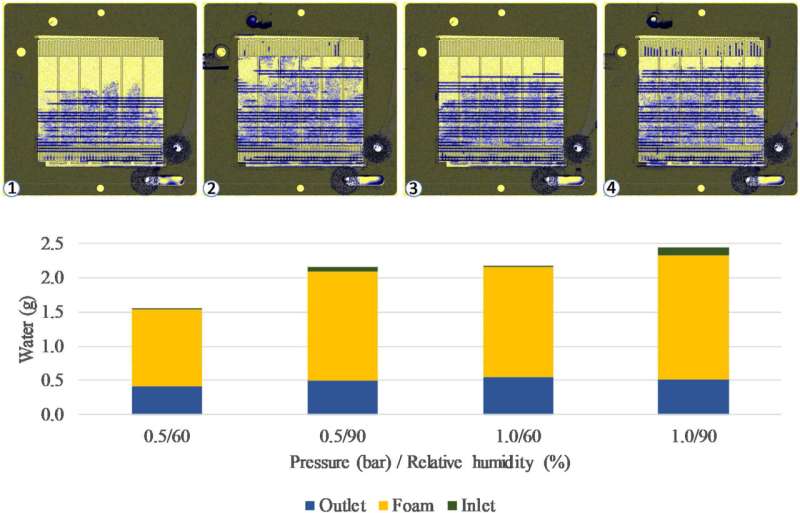This article has been reviewed according to Science X's editorial process and policies. Editors have highlighted the following attributes while ensuring the content's credibility:
fact-checked
peer-reviewed publication
trusted source
proofread
A proton exchange membrane fuel cell inspired by the structure of a lung

In a valuable contribution to ongoing research projects on development of innovative bipolar plate designs for proton exchange membrane (PEM) fuel cells, scientists from the University of Seville and the Paul Scherrer Institute have published two papers, one in the International Journal of Hydrogen Energies, and one in Electrochimica Acta.
The project's main goal is to improve the efficiency and performance of fuel cells, and the papers in question closely tie in with this purpose by addressing a critical aspect of fuel cell operation: the distribution of liquid water within steady-state cell channels.
One of the key challenges in optimal operation of PEM hydrogen cells is to ensure optimal distribution of the liquid water inside them. Excessive accumulation of water can clog proton and electron transport channels, reducing cell efficiency. On the other hand, a lack of water can cause dehydration of the membrane, which also negatively affects performance. Researchers at the University of Seville have been working on applying nature-inspired design concepts and strategies to tackle this challenge.
Their work explores how a lung-inspired structure for designing the flow circulation channels inside the cell could serve as a model for improving water distribution in PEM fuel cells. The advantage of this approach is that bioinspired structures can more efficiently facilitate the transport and distribution of water, thus addressing the problem of water accumulation or scarcity in the cell.
Such an approach has the potential to significantly improve the efficiency and durability of PEM fuel cells. By including nature-inspired structures, the project can explore new ways to optimize the distribution of water in fuel cells, which in turn leads to significant improvements in the efficiency and lifetime of fuel cells.
In short, the research reported in the papers is directed to the development of innovative bipolar plate designs. Through exploring bio-inspired solutions to address the distribution of liquid water in PEM fuel cells, the researchers offer a valuable and promising insight that may contribute to advancing fuel cell technology and, ultimately, to achieving more efficient and sustainable energy systems.
More information: Alfredo Iranzo et al, Water liquid distribution in a bioinspired PEM fuel cell, International Journal of Hydrogen Energy (2023). DOI: 10.1016/j.ijhydene.2023.08.103
G.M. Cabello González et al, Transient behavior of liquid water distribution in a lung-inspired PEM fuel cell, Electrochimica Acta (2023). DOI: 10.1016/j.electacta.2023.143414



















